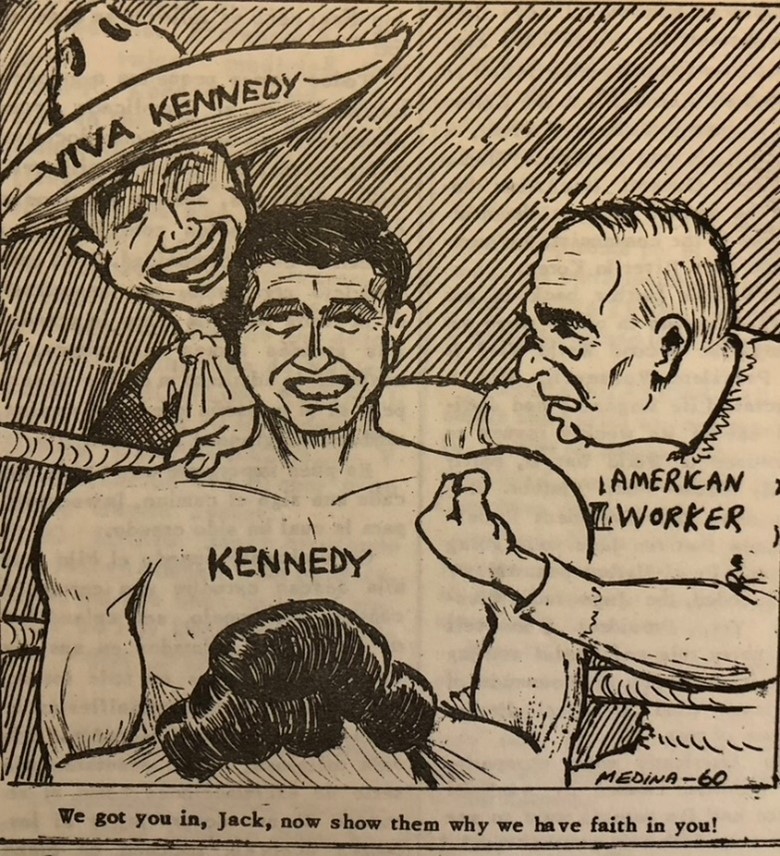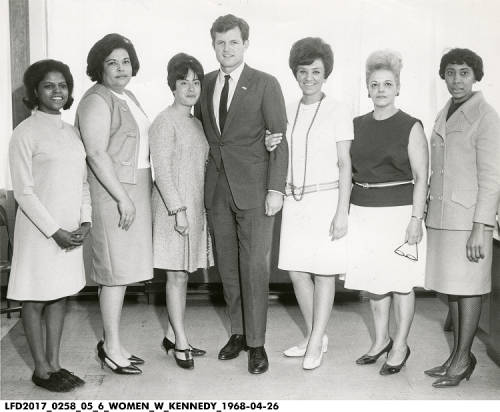
Purchase Tickets
Indiana’s Viva Kennedy Campaign
July 29, 2024

The Viva Kennedy campaign was mostly known to exist in the American southwest, originating in Arizona. It is reported that a low-level Mexican-Irish campaign worker, a Latino member of his senatorial staff, or a well-known progressive Los Angeles politician came up with the idea for the Viva Kennedy campaign, as to which is unclear. What was clear at this time, Latinos were not being politically courted by either presidential candidate. By the 1960s, Latino veterans who served with distinction in World War II and the Korean War were organizing local chapters of national Latino-serving civil rights organizations; the American G.I. Forum and League of United Latin American Citizens (LULAC). In the history of presidential campaigns, this was the first national campaign that put forth an organized effort to engage the American Spanish-speaking voter.
After the 1960 Democratic Convention, the first of many Viva Kennedy clubs (also known as Viva Kennedy-Johnson clubs) were formed to help elect Senator John F. Kennedy and simultaneously drive voter registration of U.S. Latinos, primarily Mexican Americans in the southwest. A Los Angeles city councilman, Edward Roybal was already a proven leader in earning the Latino vote and initially worked with Kennedy and his Texan running mate, Lydon Johnson on this national campaign. The first Viva Kennedy campaign headquarters was established in Arizona. While this campaign focused on Mexican Americans, many Puerto Ricans held positions with local Viva Kennedy clubs. Kennedy campaigned in the heavily Puerto Rican-populated New York neighborhood, Spanish Harlem. At his campaign stage at 116th and Lexington Avenue, his wife, Jackie, greeted the crowd in Spanish and Italian. Afterwards, he met with locals at voter registration sites. This produced a large and previously unseen Puerto Rican voter turnout in mainland politics. The national campaign and local clubs provided resources and access to a population that had never been formally democratically engaged.
In northwest Indiana, Latinos of Indiana Harbor, East Chicago, and Gary were already politically organized. They were mostly the first-generation that were the children of the Mexican pioneering families from the late 1910s and 1920s or members of the growing Puerto Rican community. And many were veterans of both World War II and the Korean War. By the end of the 1950s, they had established Democratic clubs and local chapters of national civil rights organizations like the American G.I. Forum and League of United Latin American Citizens (LULAC). In previous decades the community had cultural and mutual aid societies, established by their parents’ generation. By the end of the 1950s, young Latinos had entered local politics; the first ever elected Latino in Indiana, Joseph Maravilla was voted onto the city of East Chicago School Board in 1956, who also served as board president. This same year, the bilingual newspaper The Latin Times, rolled off the press from the famed Spanish language newspaper publisher, Figueroa Printers. This printshop initially published the first Spanish-language newspaper in Indiana in 1925. Much like its predecessor, The Latin Times helped keep residents aware of issues, both political and non-political. This new generation being politically mobilized and organized, was the perfect environment for Indiana’s only Viva Kennedy campaign headquarters.

Political Cartoon by Edward Medina, November 12, 1960
The Latin Times Newspaper, IHS
Eight months after John F. Kennedy campaigned in select Lake County cities, one of those cities being East Chicago, a Viva Kennedy Headquarters opened its doors at 3513 Main Street in the heart of the Indiana Harbor. The Viva Kennedy Headquarters was emblazoned with the official logos, the words “Viva Kennedy” inside the shape of a sombrero (Mexican wide-brimmed hat) or a cartoon-like Kennedy wearing a sombrero and riding a burro (Spanish for donkey). A car parade kicked off the opening of the headquarters. Those who were elected to this headquarters’ leadership positions were Rogelio Candelaria, Jesse Rodriguez, Valentino Martinez, Joe Alamillo, and Dr. Richard Rucoba. Louis Martinez was elected as the state chairman; Enos Guanajuato as the state vice chair; Joseph Porras as state sub-secretary and Mrs. Manuel Soto as state treasurer. In 1960, John F. Kennedy won his presidential election, with a high turnout of Latino voters. However, this would not be the last of the Kennedy family courting Indiana’s Spanish-speaking voters.
This win and national level of political engagement inspired more political mobilization within the Northwest Indiana community. In 1961 Joseph Maravilla who initially spearheaded the Viva Kennedy Club of East Chicago, launched a local chapter of a national non-partisan political association called, PASO, which stood for Political Association of Spanish Speaking Organizations. Joseph was quoted in The Hammond Times newspaper, saying that “15 of the 20 states” that participated in the Viva Kennedy movement are represented in PASO. Years later, in 1968, the Democrats of Northwest Indiana continued to be politically courted by the Kennedy family. In April, Robert F. Kennedy campaigned in Hammond, East Chicago, and Gary. Robert was hosted at a reception at St. Michael’s Ukrainian Church Hall in Hammond and a Viva Kennedy rally was held at East Chicago’s Washington High School. He later spoke at the Municipal Auditorium in Gary. It was his last visit to Indiana before the May primary. Robert, like his brother John, would later be assassinated on June 6, 1968.

Lupe T. Figueroa (third from left) with Ted Kennedy in East Chicago, April 26, 1968, Lupe T. Figueroa, IHS








